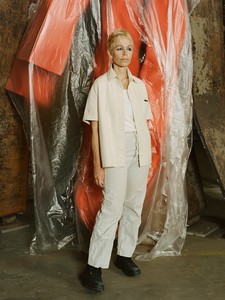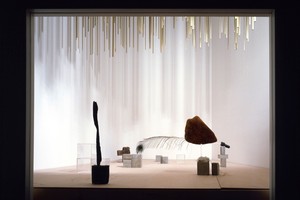
Cady Noland: Obscene
Jordan Carter, curator and cohead of the curatorial department at Dia Art Foundation, New York, engages with the new artist’s book Cady Noland: Polaroids 1986–2024.
Winter 2023 Issue
Poet Ariana Reines responds to the work of Carol Bove.

Carol Bove, New York, 2023. Photo: Jeff Henrikson
Carol Bove, New York, 2023. Photo: Jeff Henrikson
A few days after Carol Bove received a book of mine in the mail, she texted me the following poem:
Matter goes beyond matter,
The air of the earth / sculpture.
Words go beyond words,
The earth of the air / poetry.
It would be impossible to represent the range of Bove’s astonishing output in only five or six images, as I’ve so graciously been invited to do. So I’ve chosen to focus on works in which peacock feathers play a role.
I am fascinated by how Bove contrasts “apparent” heft with extremes of delicacy. I adore and am deeply attracted to skewed and “bad” proportion, which she plays with relentlessly, and with satisfying—neverending—wit. Some of Bove’s pieces seem almost to “read” with the precision of a sentence—an assortment of objects sit on a high metal plinth as if conjugated into a kind of solid grammar. Others conjure aura and relationship within and amongst themselves, or seem to beckon the viewer by engaging our acquisitive eros, by fomenting our desire to test and touch what we see, to inhabit somehow the animality of material being. At times I feel it’s pure geometry she’s gaming out, and at others the history and culture that certain
materials emanate.
In a way, everything Bove makes could be understood to be “about” strength. But to return to the ostentatious and overdetermined—already too loud in itself—peacock feather: it so happens that my last book was completed by grace of the peacock, a figure that had never previously held any particular allure for me, whose “beauty” and decorative applications felt so overfamiliar I could not really see the mysteries, the many mysteries, its obviousness concealed. What could be more feminine than a peacock feather—and yet it’s a male thing. What could be more frivolous—and yet it shows up in the most mystic of mystical places, an angelic realm whose secret of staying hidden is hiding in plain sight.
—Ariana Reines

Carol Bove, Triguna, 2012, steel, concrete, brass, peacock feather, shell, and found metal, 67 × 20 ½ × 12 ½ inches (170.2 × 52.1 × 31.8 cm). Photo: Maris Hutchinson

Carol Bove, Triguna, 2012 (detail), steel, concrete, brass, peacock feather, shell, and found metal, 67 × 20 ½ × 12 ½ inches (170.2 × 52.1 × 31.8 cm). Photo: Maris Hutchinson
ARENA
Because that light was not like the others
Making us seem to be becoming a place
& because on a traffic island the sun had filled me
& because my mother was crazy
& because she was sometimes sane
& because I was in love
& then I wasn’t in love anymore
& because I was hungry
& because I needed to party
& because I was grieving
& because I had studied the Dust Bowl, the architecture at Delphi,
Judaic & Islamic legends of Moses, Midianite theology, the history
of Haiti, Aryan horsemen of ancient Iran, the collapse of Sumerian
agriculture, Kundalini yoga, Allan Savory’s & competing theories
on desertification reversal, ancient & contemporary methods for
ruminant grazing, grasslands & myths of grasslands, those Hopi
stories that can be found in books, Roman haruspicy, Hellenistic
astrology, the life of the Marquis de Sade, one or two novels, one
or two volumes of poetry, Bulgarian choral singing, elements of
contemporary sculpture, certain Gnostic scriptures, my own appetite
& because you can pay a professional to cleanse you of demons with a
chicken egg

Carol Bove, The Occult Technology of Power, 2006, wood and metal shelves, books, peacock feathers, and concrete, 44 × 65 × 10 inches (111.8 × 165.1 × 25.4 cm). Photo: Maris Hutchinson
& because the air filled first with the odor of cheap men’s cologne
& then of human excrement over warming Pop-Tarts
& because one morning in Santa Monica a woman emerging from a store
Was heard to say “They don’t have guns in the toy store” to which her man
Replied “I know.” He was seated beside a child. “We’ll get it
In another toy store” said the man. & because an ugly incense was emanating
From HOUSE OF INTUITION & because Kabir wore
A peacock feather in his cap & Krishna had one in his turban
& because King Solomon brought peacocks, TUKKIYIM
In a boat back from Tarshish
& because I fell down sobbing over a beaded cloth
& because what I had for so long failed
To see, what I had ignored, mistaking it for ornament
Was information hiding in plain sight & because there was no way to touch
What was converging on us & because once
There were oil pits near Ardericca
& a pitch spring on Zacynthus & because Iris
Was the messenger of the gods I’d forgotten & because
“The iridescence in the peacock was due to a complex photonic
Crystal” & because that crystal was silica & so
For the most part was sand & likewise the stones
To which desolate people increasingly communicated their wishes

Carol Bove, Untitled, 2014, peacock feathers on linen in Plexiglas vitrine, 96 × 48 × 5 inches (243.8 × 121.9 × 12.7 cm). Photo: Jeffrey Sturges

Carol Bove, The Night Sky Over Berlin, March 2, 2006 at 9pm, 2006, wax, concrete, driftwood, polyurethane foam, peacock feather, steel, bronze, wood, Plexiglas, gold, 48 × 48 × 96 inches (121.9 × 121.9 × 243.8 cm). Photo: Carsten Eisfeld
& because glass was melted sand & Johnny Cash was attacked
By an ostrich & because pens used to be made of feathers
& because Chopin & George Sand had been miserable in Mallorca
& because there were dust storms on Mars
& sand storms in China & Israel was investing heavily
In anti-desertification efforts & because Papa Doc
Had shorn Haiti’s mountains of trees & when dust from Azerbaijan
Blew into Tbilisi I lay with a nihilist in a fenced-in woods
& when strange lights appeared
At the height of the spruces there was dust on our tongues
& because I navigated by the pinecone in my skull
Same as everybody else & because a bird
Had alighted on the lectern of Bernie Sanders & Mozart
Kept a sparrow as a pet & because the mute son of Kenzaburo
Oe learned speech from records of birdsongs & because
Of the bird friends of Odin & Maasaw & because the gizzards
Of fowl were iridescent & likewise the pearl
& likewise the viral “Unicorn Frappuccino” & because Big Sur
Was on fire & a hot wind was blowing over the Henry
Miller Library & because in Paradise California people burned
In their cars & because the bullets kept flying
& because the relentless spread
Of stupidity was allegorized in Flaubert’s
Novels by grains of sand & because idiocy
Came down onto Baudelaire on the wind
Of a wing & because the less we could agree
The more it seemed we were revolving
Into a gem
Artwork © Carol Bove Studio LLC
“ARENA” from A Sand Book by Ariana Reines (Tin House, 2019) © Ariana Reines

Ariana Reines is a poet, Obie-winning playwright, and performing artist. Her last book, A Sand Book, won the 2020 Kingsley Tufts Prize. Since 2020 she has run Invisible College, a platform for the study of sacred texts and poetry.

Jordan Carter, curator and cohead of the curatorial department at Dia Art Foundation, New York, engages with the new artist’s book Cady Noland: Polaroids 1986–2024.

Carlos Valladares tracks the artist’s engagements with Hollywood glamour, thinking through the ways in which the star system and its marketing engine informed his work.

Miriam Bale reports from Cannes on the 2025 edition of the international film festival, highlighting three standout films.

Harry Thorne addresses the practical and conceptual links between the visual art of Peter Doig and the work of various musicians on the occasion of Peter Doig: House of Music at Serpentine, London, an exhibition opening on October 10, 2025.

Anna Weyant’s first solo institutional exhibition, at the Museo Nacional Thyssen-Bornemisza, Madrid, was curated by Guillermo Solana in close collaboration with the artist, and places more than twenty paintings by Weyant in dialogue with a selection of works from the museum’s permanent collection. Sydney Stutterheim considers the artist’s contemporary exploration of suspense, identity, concealment, and temporality.

Brian Dillon celebrates the sonic revolutions initiated by Beach Boy Brian Wilson.

Tracking works by Chris Burden, Bruce Nauman, Maria Nordman, and Eric Orr as outliers and outcroppings of the California Light and Space movement, Michael Auping argues that darkness—the absence of light and space—is a key element of the aesthetic.

The jewelry designer Jean Schlumberger permanently changed the face of High Jewelry with his daring approach to materials and techniques. His engagement with flora and fauna from the sea to the sky, and his choice of unparalleled gems, found an eager audience during his lifetime and continues to glamour the eyes and minds of jewelry lovers today. The Quarterly’s Wyatt Allgeier explores his life, legacy, and the persistence of his studied yet whimsical work.

The Danish painter Vilhelm Hammershøi (1864–1916) has been on Ed Ruscha’s mind as he creates a new body of work for an exhibition at Gagosian, Paris, this October. Christian House visits Copenhagen to consider the quiet and persistent power of Hammershøi’s art.

A major retrospective of the work of the Colombian fiber artist Olga de Amaral has landed in Miami by way of Paris. Presented in collaboration with the Fondation Cartier pour l’art contemporain, this career-spanning exhibition will be on view at the Institute of Contemporary Art, Miami, through the fall of 2025. Here, Ekaterina Juskowski delves into the six decades of Amaral’s life, work, and inspirations.

This fall, Florence will celebrate the work of Fra Angelico with a major retrospective—the city’s first in seventy years—at both the Palazzo Strozzi and the Museo di San Marco, opening on September 26. For the occasion, Ben Street writes about the resonance of Fra Angelico’s work in modern and contemporary art.

On the occasion of two exhibitions—one at Gagosian, London, and the other at Kistefos in Jevnaker, Norway—the Quarterly shares an essay included in the forthcoming book Kathleen Ryan: 2014–24. Here, Harry Thorne writes on Kathleen Ryan’s artistic process, methods of assemblage, and how her studio resembles an excavation site.